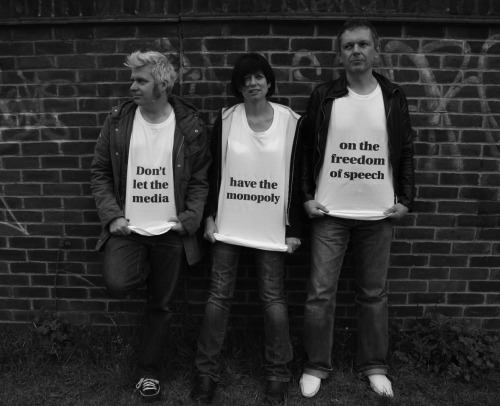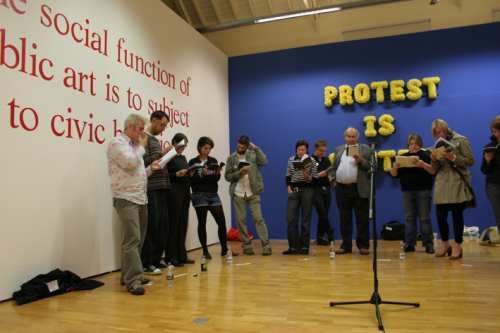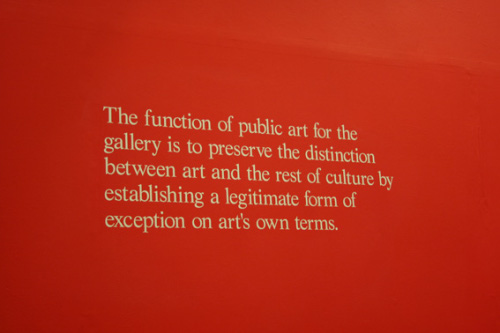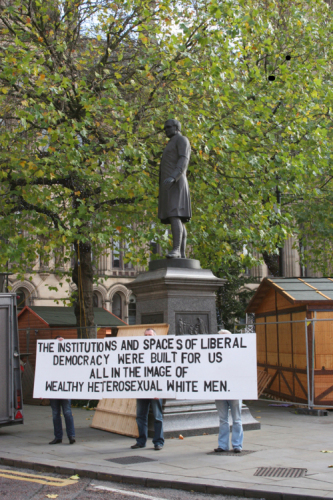Interview with Freee
Freee's art is often situated outside the confines of the gallery, but doesn't define itself as public art – indeed it is largely preoccupied with a critique of the interests served by art in public space. Josephine Berry Slater and Anthony Iles interviewed the collective (comprising Dave Beech, Mel Jordan and Andy Hewitt) about how their work navigates the tensions between making things public and thwarting public art's instrumentalisation
Do you make public art or art about public art?
We do not operate within a restricted professional genre of public art, nor is this our ‘theme', so to speak. We don't make work about the restricted field of public art. Rather, we have an understanding of art - all of it - as necessarily (though not always consciously) operating within a broad conception of the public sphere in Habermas' sense. That is to say, to put it very simply, art is something that is ‘made public', addresses a public, is published, and so on. In this respect, there is no clear dividing line between art and public art. And so our work addresses itself to art in relation to public art, and to public art in relation to art.
If we were to attempt to answer your question directly, we would say that our work is neither public art nor art about public art but counter-public art or art for a counter-public sphere. Unlike Habermas, we do not subscribe to the official public sphere. We are interested in dissensus, antagonism and protest, so the public we address is a counter-public and the public sphere we occupy is a counter-public sphere. As such, the art we produce is a counter-public art.

Image: Freee, Don’t let the media have the monopoly on the freedom of speech, poster, 2007
How do you characterise the sites and terrains of your practice? What do they have in common?
Following Wittgenstein we would argue that looking for ‘things in common' always leads to errors like essentialism, so we would have to say that the sites we use have a ‘family resemblance' instead. However, before saying what the family resemblance is, we would also want to argue that it is not a question of ‘site' for us
– we do not operate in public spaces or public places, but in the public sphere. The question of site seems to reduce the question of the public sphere to special designated official physical places (town squares, parks, civic buildings and so on) but for us the public sphere includes any act of publishing or making public, so that means it can operate in a pamphlet in your pocket or a private commercial gallery. No site is more public than another on account of its physical qualities or official designation.
David Osbaldeston has commented that our work is compromised when it returns to the gallery after appearing on the street. We think he's wrong because, in terms of the public sphere, both billboard sites and galleries are sites of publishing and making-public. They do this differently, and those differences are important and shouldn't be underestimated - galleries do not address the same public as billboard posters, nor do they address them in the same way, but they are both, if you like, part of an extended family of institutions and techniques for addressing publics, publishing and making-public.
What role does participation or collectivity play in your work?
We regard our practice as ‘beyond participation'. The problem with participation, as we see it, is twofold: that it is already limited, as a concept, by being distinct from collaboration; and the very notion of participation implies complicity on the part of the participant. We do not have participants or encourage participation because we seek dissensus – our aim is not to unify ‘the public' but to divide it (primarily by dividing opinion). Political parties, unions and so on don't have participants, they have members. So, our works aren't made to be interpreted, but to ask you to decide whether you agree with what we are saying, what we stand for, or not. If you agree, then we hope you will pass our work on, and if you disagree, then we would encourage you to make your own.
The nearest we have come to having participants in our work is the Manifesto Choir which was an event that took place prior to the private view of our solo show at International Project Space in Bourneville. This was, in a sense, our critical reworking of the idea of participation. It was a private reading of a group of invited individuals. We had previously approached people we knew and asked them if they'd like to take part, then sent them each a copy of our manifesto along with a red pen for underlining any lines that they agreed with. Then, during the reading, the three members of Freee read every word of the manifesto (we'd written it, so we agreed with it all) and the others read aloud only the sections that they had underlined, and went silent at all other times. Their ‘participation' was deliberately restricted to agreeing with us or remaining silent. It was about agonism - we expected them to feel restricted. We didn't promote a universal commonality, but raised issues about differences.
Our video work How to Talk to Buildings uses others too, and in a similar way. We worked for ARC, who have an educational agenda for regenerating Hull. And they'd asked us to do a project for Architecture Week. Instead of providing ‘the public' with experts, our starting point was the everyday experiences of local people in relation to civic architecture. We predicted a certain amount of trepidation and anxiety on their part to speak up in their inexpert ways, so we prepared for the video by talking to them about the problems of expertise and the value of ordinary experience. The videos then show these individuals standing in front of civic buildings that mean something to them, with a voiceover telling their stories about the buildings. In this way we opened up their antagonistic relationship to civic spaces - a kind of counter-expertise. Again, if this was judged according to the ethics of participation it would be too restrictive and come too late in the project, but for us the ethics of participation has to come a very distant second to the politics of counter-public dissent.

Image: Freee, The Freee art collective Manifesto for a Counter-Hegemonic Art, spoken choir, 2007
Can you explain some of the contradictions of making 'public art' indoors, say, in an art gallery? (c.f. The function of public art for the gallery,Vinyl text, 6m x 3m, 2007)
Actually, the public sphere always existed in private spaces, such as the coffee bars that Habermas talks about as the inaugural moment of the bourgeois public sphere.
There is no contradiction, but it is more complicated than thinking reductively about public space, public funding or some other ‘positive' term. The public sphere is always made up of private individuals. What makes it public is simply that they publish their opinions. They remain private individuals, and their opinions remain private, individual opinions, but by being published, the opinions then also take part in the collective attempt to arrive at shared values, decisions, and actions.
As such, we don't understand the apparent obligation to limit our conception of public encounters and publishing activities to those so-called public spaces – town square, park, ‘the street', etc. This is a very one-dimensional and unsophisticated idea of the public. It amounts to ‘the outdoors'. It is the space of monumental sculpture and passers-by. We're very critical of public monuments precisely for this reason: it doesn't get to be public just by being in public spaces, it must either have a public, construct a public or – and this is the case for most monumental sculpture, we'd argue, – simply become ideologically loaded street furniture for passersby. Passersby do not constitute a public, they are, if you like, the opposite of a public.
We are interested in dissemination, which means that a work that appears, say, on a billboard site, might then reappear on a gallery wall or be turned into a postcard or a badge. It is about the life of a slogan being passed on from one person to another, linking people through their shared beliefs and commitments. This is what a public is, in our view. And it means that we can pass on our slogans over the phone, in a photocopied pamphlet that you keep in your pocket, or passed on to others over dinner.

Image: Freee, The function of public art for the gallery is to preserve the distinction between art and the rest of culture by establishing a legitimate form of exception on art’s own terms, text, 2007
Have you been commissioned by any cultural regeneration agencies?
A little. We've worked with ARC, Creative Partnerships and the Collective Gallery's ‘One Mile' project (which pretty much mimicked a cultural regeneration agency). We have not been approached by these agencies very much because we're not part of that agenda. They wouldn't want to touch us because our slogans are too critical of their ideology. We're not interested in a site or a context or a community as the theme of our work, and we're not trying to ‘do good deeds' or solve anyone's problems. We're not convivial enough. We want more antagonism, more problems, more dissent. For instance, our first inclination when invited by The Collective Gallery to work with local Polish people within a mile radius of the gallery was to go to Poland to find an alternative public. Nowadays, too, they often want visual spectacles to celebrate or brand a particular place, as part of a regeneration project. They all want a landmark sculpture, an ‘Angel of the North'. We don't make that kind of work.
In what ways have commissioning agencies set the conditions for your work in public space?
There is some tension, usually, but we have also worked with some really supportive and brilliant institutions. The thing is, though, that all our work is commissioned. Whoever we work with, whoever pays for the production of the work, will have their own agenda (often set by government policy on which their funding depends).
Art and Architecture magazine wanted to use an old work of ours to publicize its conference in 2005. We insisted on them commissioning a new work, which ended up as Artists Cannot Bring Integrity to your project... They rejected the work. In effect, it didn't match their conditions – PR guff. So we pulled it and got it in guerrilla-style.
We think our work for the Collective Gallery was a compromise between what we wanted to do and their conditions. They wanted us to theme the show around Polishness. We expanded this to a critique of multiculturalism, but still our work was a response to their agenda, rather than an agenda of our own. We won't make that mistake again.

Image: Freee, Artists cannot bring integrity to your project unless they provide a full and candid critique of everything you do, text, poster, 2005
Can you explain the specific operation of 'site-specificity' in your practice?
We have a problem with the concept of site-specificity. It seems to be one-dimensional, turning the public (which we think of as constructed in the very act of ‘going public' and making-public, of dividing opinion and constructing agreement) into a place or a building. Our alternative to this kind of essentialist thinking is our notion of publishing, which has a performative relationship with the public, constructing temporary publics on the move rather than fixing them to a specific place. Sites are merely physical even if they have a history, a multitude of uses and so on. But if the public is formed through the various acts of publishing and opinion formation then it is not necessarily found outdoors or in so-called public spaces.
What are your thoughts on the role of critique in legitimating cultural institutions, agencies and the culture industry in general?
If critique has become part of the legitimation of art's institutions, then we have to see that as a victory for the traditions of critique. Only an oppositional politics would abandon its project once that project has gained a certain amount of power. The Left didn't critique society in order to remain outside it, but in order to change it. We therefore stand by those projects that have been taken on by arts institutions and push for more concessions, more power, more change. At the same time, we are heartened by the possibility that arts institutions might overestimate their own power to neutralize critique by incorporating it. Let them incorporate even more! Let's saturate the fuckers with critique! Let's see how they neutralize that!
You explicitly understand regeneration as 'state-backed gentrification'. Is it ever possible to harness the many-headed hydra of urban regeneration as a means to realise a meaningful transformation of the urban environment? Is it only possible to critique this phenomenon from inside it?
That seems to be a simplistic view of regeneration to us. Regeneration does not boil down to gentrification. Gentrification is about real estate. Regeneration is also about getting people to behave differently. It goes on in schools, with the criminal population. It is social policy more than anything: education, aspiration, employment, the economy and so on.
The question of gentrification has to be linked to property. If we had gentrification without property prices going up and developers and individuals moving in on the newly gentrified properties – if, in other words, gentrification was done with a guarantee that the communities could hold on to their properties and they would not be privatised - then we would not regard gentrification as the social evil that it is. But this would mean protecting social housing, safeguarding public ownership of housing, and investing in social housing without an eye on the private sector.

Image: Freee, How to talk to Public Art (White Men), video still, 2005
That is to talk about gentrification, about real estate. Regeneration would not be about social control but real active, dissenting citizenship. Regeneration would not simply be an arm of planning – something that ‘happens' to us. It would have to be something that we did, locally, together. And it would mean collective opinion formation and collective will formation leading to collective action.
Regeneration links gentrification (and subsequently the privatization of social housing) to issues of social control, crime prevention and the like. So this makes it worse. The poor are not given better chances, they are simply hegemonised into accepting their poverty without turning to anti-social and criminal activities.
Freee is a collective made up of 3 artists, Dave Beech, Andy Hewitt and Mel Jordan, who have been working together since 2004 on slogans, performances, billboards, manifestos and other publications that challenge the commercial and bureaucratic colonisation of the public sphere of opinion formation. Recent exhibitions include Revolution is Sublime for Camberwell Space's exhibition ‘The Peckham Experiment' curated by Space Station 65, 'Revolution Road: Rename the Streets!' at Wysing Arts and Zoo, and Spin[Freee]oza at Smart Project Space, Amsterdam.
Mute Books Orders
For Mute Books distribution contact Anagram Books
contact@anagrambooks.com
For online purchases visit anagrambooks.com






